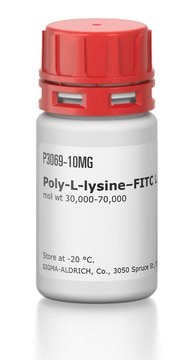93426
Triton™ X-100
BioXtra, for molecular biology
Synonym(s):
t-Octylphenoxypolyethoxyethanol, Polyethylene glycol tert-octylphenyl ether
About This Item
Recommended Products
grade
Molecular Biology
for molecular biology
description
non-ionic
product line
BioXtra
form
liquid
mol wt
micellar avg mol wt 80,000
average mol wt 625
aggregation number
100-155
technique(s)
flow cytometry: suitable
immunofluorescence: suitable
permeability assay: suitable
impurities
DNases, none detected
RNases, none detected
phosphatases, none detected
proteases, none detected
ign. residue
≤0.2%
CMC
0.2-0.9 mM (20-25°C)
transition temp
cloud point 65 °C
pour point ~7 °C
solubility
H2O: 0.005 M at 20 °C, clear, colorless
density
1.065 g/mL at 20 °C
anion traces
chloride (Cl-): ≤50 mg/kg
sulfate (SO42-): ≤50 mg/kg
cation traces
Ca: ≤10 mg/kg
Cd: ≤5 mg/kg
Co: ≤5 mg/kg
Cr: ≤5 mg/kg
Cu: ≤5 mg/kg
Fe: ≤5 mg/kg
K: ≤500 mg/kg
Mg: ≤5 mg/kg
Mn: ≤5 mg/kg
Na: ≤500 mg/kg
Ni: ≤5 mg/kg
Pb: ≤5 mg/kg
Zn: ≤5 mg/kg
HLB
13.5
storage temp.
2-8°C
SMILES string
CC(C)(C)CC(C)(C)c1ccc(OCCOCCOCCOCCOCCOCCOCCO)cc1
InChI
1S/C28H50O8/c1-27(2,3)24-28(4,5)25-6-8-26(9-7-25)36-23-22-35-21-20-34-19-18-33-17-16-32-15-14-31-13-12-30-11-10-29/h6-9,29H,10-24H2,1-5H3
InChI key
HNLXNOZHXNSSPN-UHFFFAOYSA-N
Looking for similar products? Visit Product Comparison Guide
General description
Application
Biochem/physiol Actions
Principle
Legal Information
signalword
Danger
hcodes
Hazard Classifications
Acute Tox. 4 Oral - Aquatic Acute 1 - Aquatic Chronic 1 - Eye Dam. 1 - Skin Irrit. 2
Storage Class
10 - Combustible liquids
wgk_germany
WGK 3
flash_point_f
483.8 °F - closed cup
flash_point_c
251 °C - closed cup
ppe
Eyeshields, Faceshields, Gloves, type ABEK (EN14387) respirator filter
Choose from one of the most recent versions:
Already Own This Product?
Find documentation for the products that you have recently purchased in the Document Library.
Active Filters
Our team of scientists has experience in all areas of research including Life Science, Material Science, Chemical Synthesis, Chromatography, Analytical and many others.
Contact Technical Service






